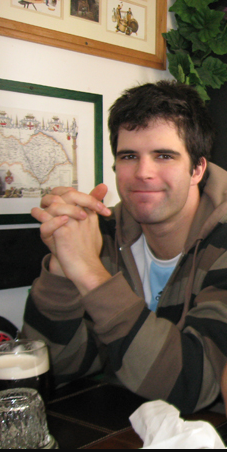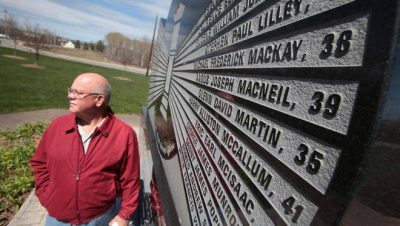#97 Getting away with murder
Hell’s History: The United Steelworkers’ Fight to Prevent Workplace Deaths and Injuries from the 1992 Westray Mine Disaster through 2016
by Tom Sandborn
Vancouver: United Steelworkers, 2016
9780995843707
Out of print in hard copy but free digital copy available here.
Reviewed by Ron Verzuh
First published Mar. 1, 2017
*
 Tom Sandborn’s Hell’s History opens with the deaths of twenty-six Nova Scotia miners in an underground explosion in 1992.
Tom Sandborn’s Hell’s History opens with the deaths of twenty-six Nova Scotia miners in an underground explosion in 1992.
Sandborn shows how the federal government’s Westray Act of 2004, while well-meaning, in practice has lacked the teeth to prevent and prosecute more recent workplace deaths.
Hell’s History tells the story of twenty-four year old Sam Fitzpatrick of Squamish, fatally injured in February 2009 in an industrial accident at Toba Inlet while rock-scaling for Vancouver-based Peter Kiewit Sons Co., a subsidiary of the Kiewit Corporation, an American multinational.
Reviewer Ron Verzuh charts a reckless corporate “path to disaster” that persists today.
— Ed.
*

When it comes to workplace deaths, history keeps repeating itself — and we keep getting reminded that we need to learn from history. Writer Tom Sandborn and the health and safety conscious United Steelworkers union (USW) tell us how and why in a short book pulsating with the shocking details of the 1992 Westray Mine explosion and other preventable tragedies.
Sandborn does not tell us anything new here; Westray became a catalyst for union action and the details were well publicized.
What is new, however, is Sandborn’s linking of Westray to other deadly workplace events in British Columbia and elsewhere. In so doing, he reveals the consistent failure of governments, police, and workers’ compensation agencies to prosecute employers.

The Westray explosion occurred nearly thirty years ago in Plymouth, Nova Scotia, killing twenty-six miners and igniting public outrage from families, friends, and concerned groups like the USW.
As Sandborn explains, the union lobbied for a law that would help prosecute those guilty of workplace deaths after Curragh Resources Inc., the Westray parent company, slipped away without a single manager being held responsible.
After a ten-year effort, in 2004 the federal government passed the Westray Act. With the new law on the books, it appeared that Canadian workers endangered by profit-hungry and safety-negligent employers would finally be protected.
Sandborn acknowledges the importance of the new law, but explains that the problem soon became a failure to enforce it. He lists the many failures to comply with the new act since Westray.

In the longest chapter in this generously illustrated book, Sandborn interviews several family members of the victims of what amounts to workplace murder with impunity. He lists the twenty-six miners who died, and recounts more recent workplace deaths of other workers.
Sam Fitzpatrick, for example, a young B.C. worker killed at the Toba Inlet worksite of Peter Kiewit Sons Co., a large multinational construction company. “They ought to slap the cuffs on them,” Sam’s father Brian Fitzpatrick told Sandborn, referring to managers. They are just one guilty party in a lengthening list.
When the Nova Scotia government finally took action regarding Westray, they might have been more careful what they wished for when it assigned Supreme Court Justice K. Peter Richard to investigate.
Justice Richard found that Westray represented “a predictable path to disaster” (26).
In uncommonly strong language, he reported on Westray’s “disdain for safety,” adding that the disaster revealed a case of “incompetence, of mismanagement, of bureaucratic bungling, of deceit, of ruthlessness, of coverup, of apathy, of expediency and of cynical indifference” (26).
Sandborn, whose reports of the workplace and the labour movement appear regularly in The Tyee (tyee.ca), has produced a moving reminder of what occurred at the Westray Mine.
More than that, he has exposed the continuing failure of government authorities, in spite of the Westray Act, to prevent more Westrays.

“The Westray miners died because management put production and profit ahead of safety,” Sandborn writes, and he uses Hell’s History to show “a pattern that repeats itself all too often in the years after the mine exploded” (17).
That history brings shame to all those who have turned a deaf ear to the lessons of the past.
Sandborn’s book, like the miner’s canary of old that signalled danger to the men of the deep, serves as a warning to government agencies that they need to enforce the law and prosecute violators.
Working people need politicians and bureaucrats to pay attention to the laws that are supposed to protect their safety.
*

Ron Verzuh is a writer and historian who worked for a national union for twenty-five years. For information on the USW campaign to enforce the law, see www.stopthekilling.ca
*
The Ormsby Review. More Readers. More Reviews. More Often.
One comment on “#97 Getting away with murder”
Comments are closed.